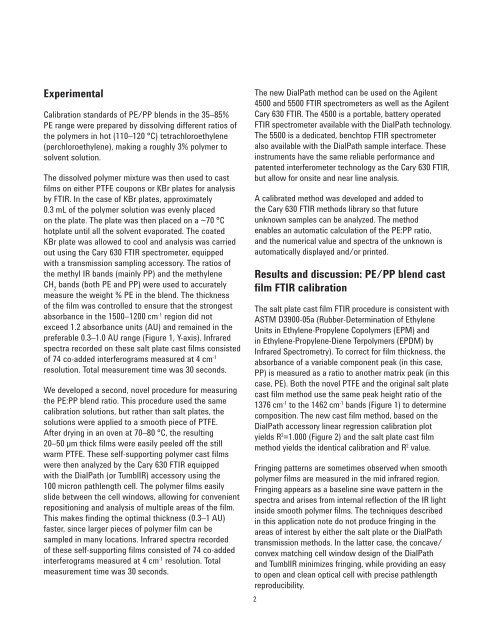Application Compendium - Agilent Technologies
Application Compendium - Agilent Technologies
Application Compendium - Agilent Technologies
Create successful ePaper yourself
Turn your PDF publications into a flip-book with our unique Google optimized e-Paper software.
Experimental<br />
Calibration standards of PE/PP blends in the 35–85%<br />
PE range were prepared by dissolving different ratios of<br />
the polymers in hot (110–120 °C) tetrachloroethylene<br />
(perchloroethylene), making a roughly 3% polymer to<br />
solvent solution.<br />
The dissolved polymer mixture was then used to cast<br />
films on either PTFE coupons or KBr plates for analysis<br />
by FTIR. In the case of KBr plates, approximately<br />
0.3 mL of the polymer solution was evenly placed<br />
on the plate. The plate was then placed on a ~70 °C<br />
hotplate until all the solvent evaporated. The coated<br />
KBr plate was allowed to cool and analysis was carried<br />
out using the Cary 630 FTIR spectrometer, equipped<br />
with a transmission sampling accessory. The ratios of<br />
the methyl IR bands (mainly PP) and the methylene<br />
CH 2 bands (both PE and PP) were used to accurately<br />
measure the weight % PE in the blend. The thickness<br />
of the film was controlled to ensure that the strongest<br />
absorbance in the 1500–1200 cm -1 region did not<br />
exceed 1.2 absorbance units (AU) and remained in the<br />
preferable 0.3–1.0 AU range (Figure 1, Y-axis). Infrared<br />
spectra recorded on these salt plate cast films consisted<br />
of 74 co-added interferograms measured at 4 cm -1<br />
resolution. Total measurement time was 30 seconds.<br />
We developed a second, novel procedure for measuring<br />
the PE:PP blend ratio. This procedure used the same<br />
calibration solutions, but rather than salt plates, the<br />
solutions were applied to a smooth piece of PTFE.<br />
After drying in an oven at 70–80 °C, the resulting<br />
20–50 µm thick films were easily peeled off the still<br />
warm PTFE. These self-supporting polymer cast films<br />
were then analyzed by the Cary 630 FTIR equipped<br />
with the DialPath (or TumblIR) accessory using the<br />
100 micron pathlength cell. The polymer films easily<br />
slide between the cell windows, allowing for convenient<br />
repositioning and analysis of multiple areas of the film.<br />
This makes finding the optimal thickness (0.3–1 AU)<br />
faster, since larger pieces of polymer film can be<br />
sampled in many locations. Infrared spectra recorded<br />
of these self-supporting films consisted of 74 co-added<br />
interferograms measured at 4 cm -1 resolution. Total<br />
measurement time was 30 seconds.<br />
The new DialPath method can be used on the <strong>Agilent</strong><br />
4500 and 5500 FTIR spectrometers as well as the <strong>Agilent</strong><br />
Cary 630 FTIR. The 4500 is a portable, battery operated<br />
FTIR spectrometer available with the DialPath technology.<br />
The 5500 is a dedicated, benchtop FTIR spectrometer<br />
also available with the DialPath sample interface. These<br />
instruments have the same reliable performance and<br />
patented interferometer technology as the Cary 630 FTIR,<br />
but allow for onsite and near line analysis.<br />
A calibrated method was developed and added to<br />
the Cary 630 FTIR methods library so that future<br />
unknown samples can be analyzed. The method<br />
enables an automatic calculation of the PE:PP ratio,<br />
and the numerical value and spectra of the unknown is<br />
automatically displayed and/or printed.<br />
Results and discussion: PE/PP blend cast<br />
film FTIR calibration<br />
The salt plate cast film FTIR procedure is consistent with<br />
ASTM D3900-05a (Rubber-Determination of Ethylene<br />
Units in Ethylene-Propylene Copolymers (EPM) and<br />
in Ethylene-Propylene-Diene Terpolymers (EPDM) by<br />
Infrared Spectrometry). To correct for film thickness, the<br />
absorbance of a variable component peak (in this case,<br />
PP) is measured as a ratio to another matrix peak (in this<br />
case, PE). Both the novel PTFE and the original salt plate<br />
cast film method use the same peak height ratio of the<br />
1376 cm -1 to the 1462 cm -1 bands (Figure 1) to determine<br />
composition. The new cast film method, based on the<br />
DialPath accessory linear regression calibration plot<br />
yields R 2 =1.000 (Figure 2) and the salt plate cast film<br />
method yields the identical calibration and R 2 value.<br />
Fringing patterns are sometimes observed when smooth<br />
polymer films are measured in the mid infrared region.<br />
Fringing appears as a baseline sine wave pattern in the<br />
spectra and arises from internal reflection of the IR light<br />
inside smooth polymer films. The techniques described<br />
in this application note do not produce fringing in the<br />
areas of interest by either the salt plate or the DialPath<br />
transmission methods. In the latter case, the concave/<br />
convex matching cell window design of the DialPath<br />
and TumblIR minimizes fringing, while providing an easy<br />
to open and clean optical cell with precise pathlength<br />
reproducibility.<br />
2

















